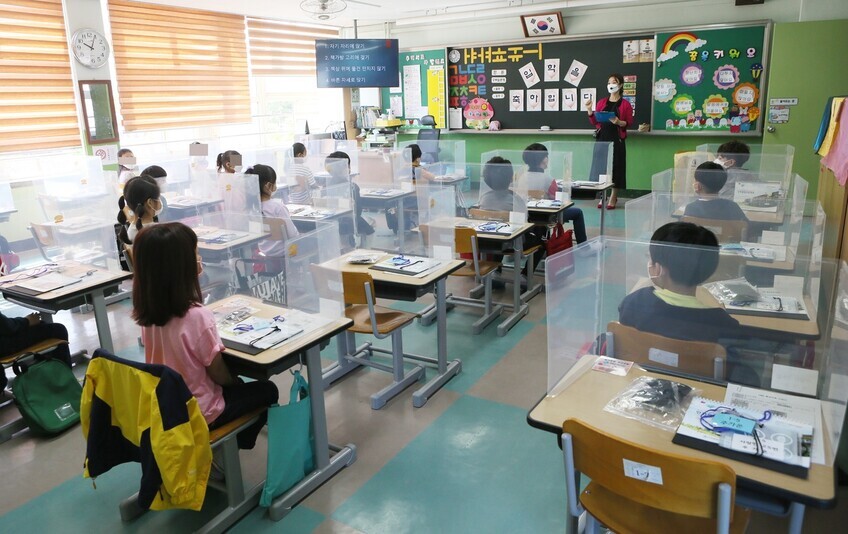hankyoreh
Links to other country sites 다른 나라 사이트 링크
Education Ministry deliberates over allowing more students to take on-campus classes

With full-scale on-campus classes in public schools an unlikely prospect for the fall semester as the COVID-19 pandemic continues, the Ministry of Education (MOE) plans to make a decision this week on whether to increase the number of students attending on-campus classes in the Seoul Capital Area (SCA) and in Gwangju as it wrestles with the issue of academic disparities being exacerbated by remote education.
“At present, the number of students attending on-campus classes at kindergartens and elementary and middle schools in the SCA and in Gwangju has been restricted to one-third of the total student body,” an MOE official explained on July 26.
“We plan to make a decision and notify schools within the week on whether we’re loosening that restriction to two-thirds,” the official said. In a Q&A session in the areas of education, society, and culture held at the National Assembly on July 24, Deputy Prime Minister and Minister of Education Yoo Eun-hae said, “Full-scale on-campus classes may not be possible in the second semester under the current stage [with the virus continuing to spread].”
“But we currently have up to one-third of students in Greater Seoul attending in person, and we could have a situation where that gets expanded to two-thirds,” she added.
On May 24, the MOE announced measures to minimize crowding in schools, recommending that schools prevent the number of students on campus at any given time to exceed two-thirds of the student body. Disease control measures were subsequently intensified in the SCA on May 29 amid an inflection cluster originating in Itaewon’s clubbing district. In response, the MOE intensified restrictions to allow only up to one-third of the student body at kindergartens and elementary and middle schools. The same restrictions on in-person attendance have also been imposed between July 6 and the start of summer vacation in Gwangju, where fears of community transmission have grown since a cluster of infections linked to door-to-door sales operations broke out in late June.
MOE likely to maintain ⅔ guideline fall semesterThe MOE appears likely to maintain its “two-thirds” guideline into the fall semester. The key question is what happens with community transmissions going forward. In the SCA, disease control restrictions have been loosened since July 20 with the reopening of public facilities like museums and libraries -- yet small-scale cluster infections have continued unabated. Concerns remain even in Gwangju, where the number of new daily cases has recently fallen to the single digits.
From the MOE’s standpoint, it cannot overlook the reality of growing fatigue among students and the deepening of academic disparities as the combination of remote and in-person classes continues over the long term. Increasing the percentage of on-campus classes by relaxing restrictions on the permissible number of students could lead to better in-person support for students from vulnerable demographics and those who are behind academically. In the July 24 Q&A session, Yoo said, “Based on the midterm examination results, assessments for the middle segment of students had fallen.”
“After finishing the diagnostics for the 17 metropolitan and provincial offices of education, we plan to develop different support models to customize them for individual students,” she said.
Lee Yu-jin, staff reporter
Please direct comments or questions to [english@hani.co.kr]

Editorial・opinion
![[Editorial] Penalties for airing allegations against Korea’s first lady endanger free press [Editorial] Penalties for airing allegations against Korea’s first lady endanger free press](https://flexible.img.hani.co.kr/flexible/normal/500/300/imgdb/original/2024/0502/1817146398095106.jpg) [Editorial] Penalties for airing allegations against Korea’s first lady endanger free press
[Editorial] Penalties for airing allegations against Korea’s first lady endanger free press![[Editorial] Yoon must halt procurement of SM-3 interceptor missiles [Editorial] Yoon must halt procurement of SM-3 interceptor missiles](https://flexible.img.hani.co.kr/flexible/normal/500/300/imgdb/child/2024/0501/17145495551605_1717145495195344.jpg) [Editorial] Yoon must halt procurement of SM-3 interceptor missiles
[Editorial] Yoon must halt procurement of SM-3 interceptor missiles- [Guest essay] Maybe Korea’s rapid population decline is an opportunity, not a crisis
- [Column] Can Yoon steer diplomacy with Russia, China back on track?
- [Column] Season 2 of special prosecutor probe may be coming to Korea soon
- [Column] Park Geun-hye déjà vu in Yoon Suk-yeol
- [Editorial] New weight of N. Korea’s nuclear threats makes dialogue all the more urgent
- [Guest essay] The real reason Korea’s new right wants to dub Rhee a founding father
- [Column] ‘Choson’: Is it time we start referring to N. Korea in its own terms?
- [Editorial] Japan’s rewriting of history with Korea has gone too far
Most viewed articles
- 160% of young Koreans see no need to have kids after marriage
- 2Presidential office warns of veto in response to opposition passing special counsel probe act
- 3[Editorial] Penalties for airing allegations against Korea’s first lady endanger free press
- 4Months and months of overdue wages are pushing migrant workers in Korea into debt
- 5Japan says it’s not pressuring Naver to sell Line, but Korean insiders say otherwise
- 630th anniversary Wednesday Demonstration pushed out of memorial site by far-right
- 7Inside the law for a special counsel probe over a Korean Marine’s death
- 8Dermatology, plastic surgery drove record medical tourism to Korea in 2023
- 9[Guest essay] Maybe Korea’s rapid population decline is an opportunity, not a crisis
- 10Trump asks why US would defend Korea, hints at hiking Seoul’s defense cost burden